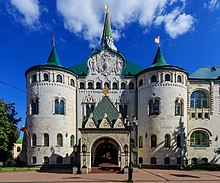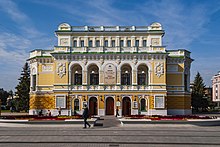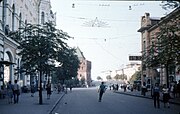|
Bolshaya Pokrovskaya Street
Bolshaya Pokrovskaya Street (Russian: Большая Покровская улица, lit. 'Greater Intercession Street'; short-name — Pokrovka, Russian: Покровка) is the high street in the historical centre of Nizhny Novgorod and one of its oldest streets. Until 1917 it was considered a street for noblemen. Formed the main street of the city by the end of the 18th century. It is considered an analog of the Arbat in Moscow or 6-7 Lines of Vasilyevsky Island in St. Petersburg. HistoryRussian EmpireThe street began to form in the Middle Ages. Then its direction was set on the road to Moscow. After the visit of Empress Catherine II, a new regular city plan was developed, providing for a quarterly system.[1] In 1823 - 1824 the bell tower at the church of the Protection of the Holy Virgin (Russian: Церковь Покрова Пресвятой Богородицы) was built. At the end of the 16th to the beginning of the 19th centuries stone buildings were added to the street.[2] Since then it has become the main street of the city and has become known as the "noble family", because of the location on it of the estate of the generals, princely families, the governor, the vice-governor and other high officials.[3] In 1896 Nicholas Theater was built, the opening of which was timed to coincide with the beginning of the All-Russia Exhibition. On 18 July 1896, it was visited by Emperor Nicholas II.[4] Soviet periodAfter the revolution, the street was renamed and began to bear the name of the revolutionary Yakov Sverdlov and was popularly called "Sverdlovsk". Approximately in 1935, the Church of the Intercession was demolished. Until the 1980s, the street was a road, and in the early 80's it was made pedestrian. Current RussiaAfter the dissolution of the Soviet Union, the street was renamed back to Bolshaya Pokrovskaya. In 2004 the 21st century the street was completely reconstructed.
Attractions     
InterestingBuskersEvery day street musician plays here. They play in different musical styles and repertoires.[5] The attitude of the city police towards street musicians is loyal. Unlike the Moscow Arbat, musicians here are not banished from the street and are not fined. If they do not violate public order.[5] Street artistsNear the philological faculty of the UNN, there are various artists and artisans. There's also organized an impromptu exhibition fair of their works. The artists can order portraits, caricatures, and still lifes, and artisans can order a variety of wicker products, pottery, and more.[6] SculpturesFrom Minin and Pozharsky Square towards Gorky Square:
References
|
||||||||||||||||




